Triboelectric Nanogenerators: State of the Art
Abstract
:1. Introduction
2. Overview of Triboelectric Nanogenerator
2.1. Electrical Principles
2.2. Operating Mode
2.3. Electrical Polarity of the Friction Layer Material
3. Current Status of Applied Research
3.1. Self-Powered Sensing
3.2. Blue Energy
3.3. Micro/Nano Power Sources
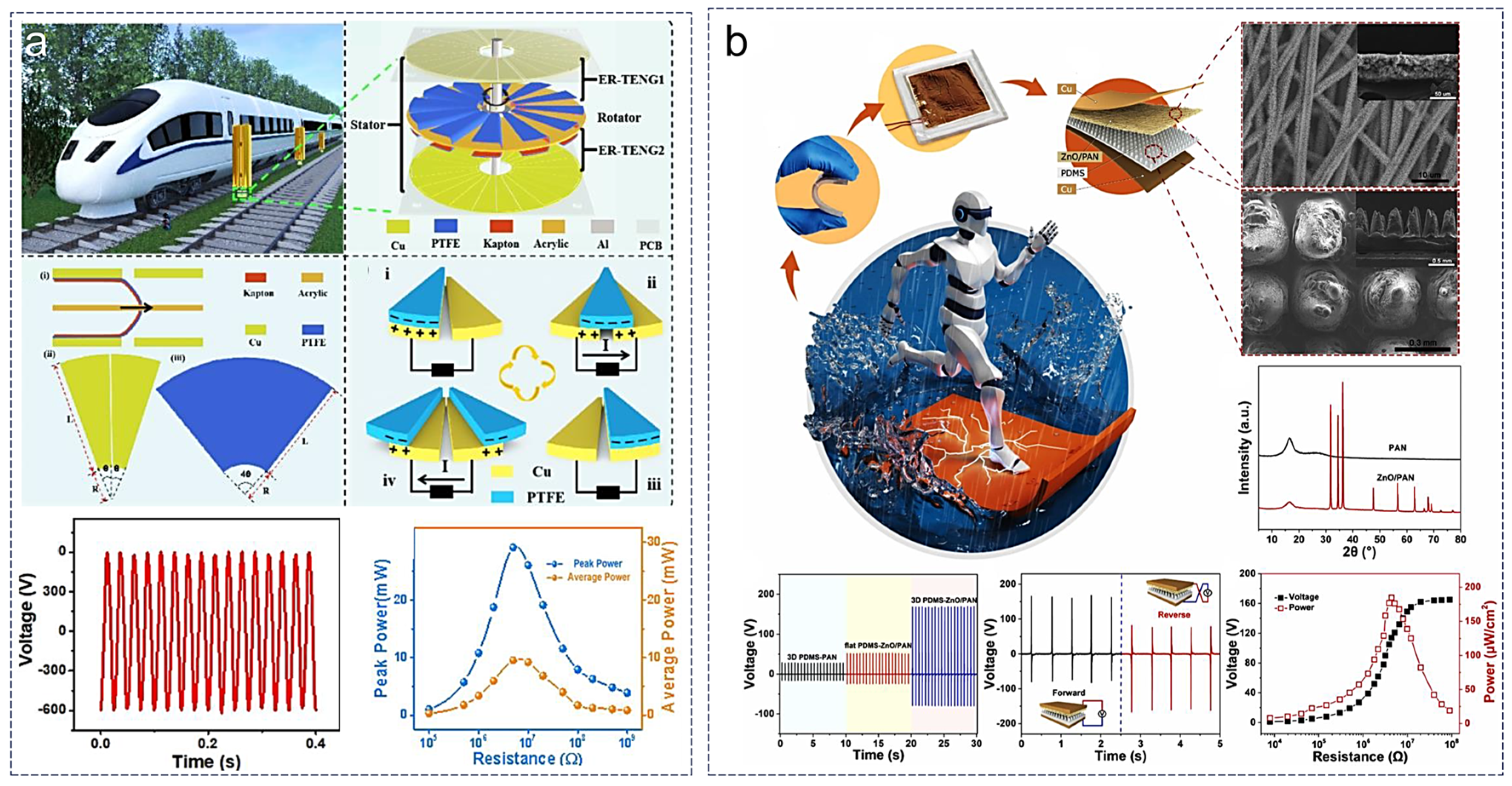
3.4. HV Power Sources
4. Improvement Strategies for Performances
4.1. Energy Management
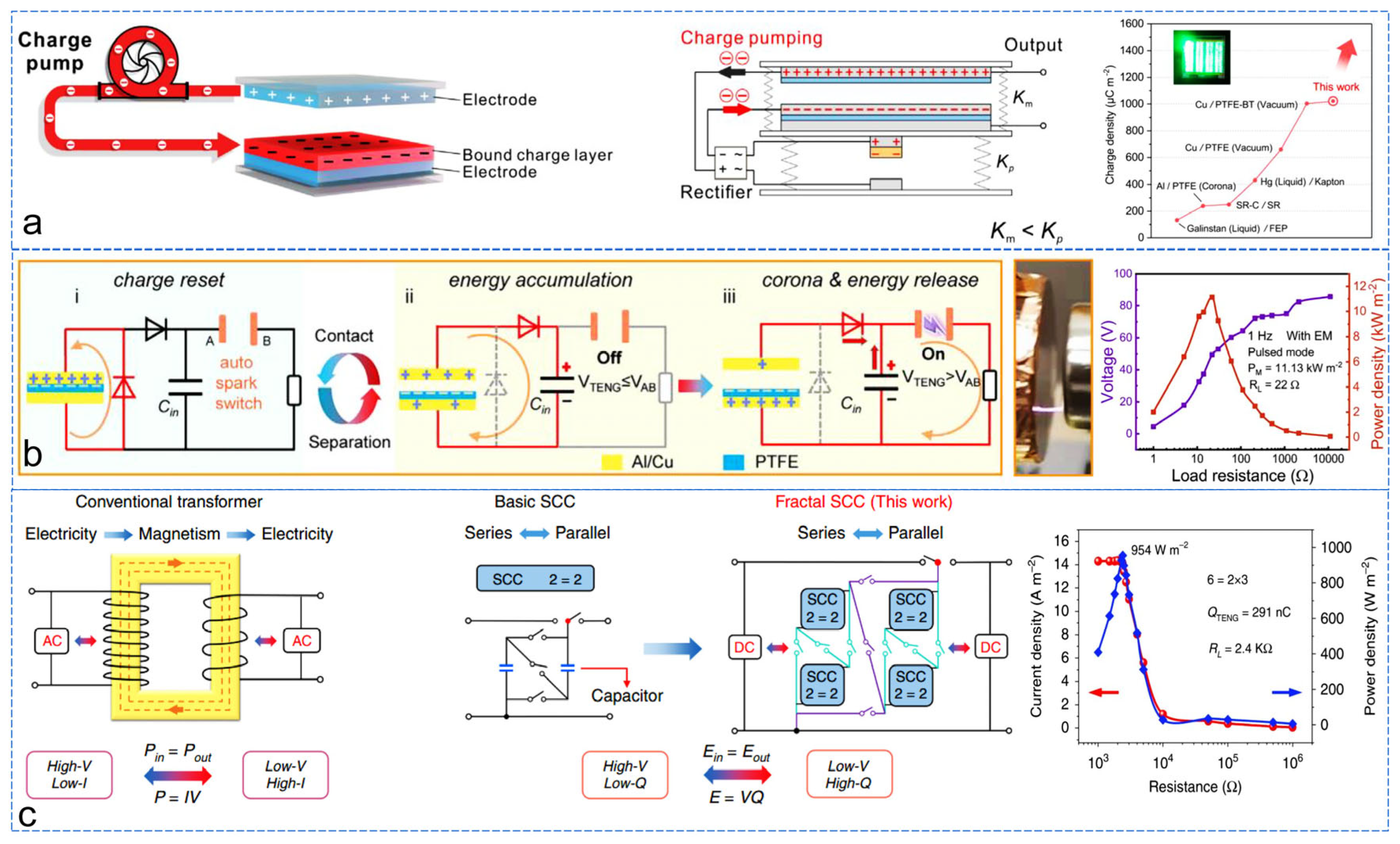
4.2. Structural Improvement
4.3. Material Modification
5. Conclusions and Challenges
5.1. Summary
5.2. Challenges and Prospects
Author Contributions
Funding
Conflicts of Interest
References
- Gaikwad, A.M.; Khau, B.V.; Davies, G.; Hertzberg, B.; Steingart, D.A.; Arias, A.C. A high areal capacity flexible lithium-ion battery with a strain-compliant design. Adv. Energy Mater. 2014, 5, 1401389. [Google Scholar] [CrossRef]
- Fang, L.; Zheng, Q.; Hou, W.; Zheng, L.; Li, H. A self-powered vibration sensor based on the coupling of triboelectric Nanogenerator and electromagnetic generator. Nano Energy 2022, 97, 107164. [Google Scholar] [CrossRef]
- Hu, C.; Yang, Y.; Wang, Z.L. Quantitative comparison between the effective energy utilization efficiency of triboelectric nanogenerator and electromagnetic generator post power management. Nano Energy 2022, 103, 107760. [Google Scholar] [CrossRef]
- Zhao, B.; Li, Z.; Liao, X.; Qiao, L.; Li, Y.; Dong, S.; Zhang, Z.; Zhang, B. A heaving point absorber-based ocean wave energy convertor hybridizing a multilayered soft-brush cylindrical triboelectric generator and an electromagnetic generator. Nano Energy 2021, 89, 106381. [Google Scholar] [CrossRef]
- Zhao, J.; Zhen, G.; Liu, G.; Bu, T.; Liu, W.; Fu, X.; Zhang, P.; Zhang, C.; Wang, Z.L. Remarkable merits of triboelectric Nanogenerator than electromagnetic generator for harvesting small-amplitude mechanical energy. Nano Energy 2019, 61, 111–118. [Google Scholar] [CrossRef]
- Cho, H.; Kim, I.; Park, J.; Kim, D. A waterwheel hybrid generator with disk triboelectric nanogenerator and electromagnetic generator as a power source for an electrocoagulation system. Nano Energy 2022, 95, 107048. [Google Scholar] [CrossRef]
- Carneiro, P.M.R.; Vidal, J.V.; Rolo, P.; Peres, I.; Ferreira, J.A.F.; Kholkin, A.L.; Soares dos Santos, M.P. Instrumented electro-magnetic generator: Optimized performance by automatic self-adaptation of the generator structure. Mech. Syst. Signal Process. 2022, 171, 108898. [Google Scholar] [CrossRef]
- Ahmed, A.; Hassan, I.; Helal, A.S.; Sencadas, V.; Radhi, A.; Jeong, C.K.; El-Kady, M.F. Triboelectric nanogenerator versus piezoelectric generator at low frequency (<4 Hz): A Quantitative Comparison. iScience 2020, 23, 101286. [Google Scholar] [CrossRef]
- Zhi, C.; Shi, S.; Wu, H.; Si, Y.; Zhang, S.; Lei, L.; Hu, J. Emerging trends of nanofibrous piezoelectric and triboelectric applications: Mechanisms, electroactive materials, and designed architectures. Adv. Mater. 2024, 36, e2401264. [Google Scholar] [CrossRef]
- Wardhana, E.M.; Mutsuda, H.; Tanaka, Y.; Nakashima, T.; Kanehira, T.; Maeda, S.; Yamauchi, M. Characteristics of electric performance and key factors of a hybrid piezo/triboelectric generator for wave energy harvesting. Sustain. Energy Technol. Assess. 2022, 50, 101757. [Google Scholar] [CrossRef]
- Gao, F.; Zhao, X.; Zhang, Z.; An, L.; Xu, L.; Xun, X.; Zhao, B.; Ouyang, T.; Zhang, Y.; Liao, Q.; et al. A stretching-insensitive, self-powered and wearable pressure sensor. Nano Energy 2022, 91, 106695. [Google Scholar] [CrossRef]
- Gao, F.; Zhang, Z.; Zhao, X.; An, L.; Xu, L.; Xun, X.; Zhao, B.; Ouyang, T.; Kang, Z.; Liao, Q.; et al. Highly conductive and stretching-insensitive films for wearable accurate pressure perception. Chem. Eng. J. 2021, 429, 132488. [Google Scholar] [CrossRef]
- Tao, X.; Zhou, Y.; Qi, K.; Guo, C.; Dai, Y.; He, J.; Dai, Z. Wearable textile triboelectric generator based on nanofiber core-spun yarn coupled with electret effect. J. Colloid. Interface Sci. 2022, 608, 2339–2346. [Google Scholar] [CrossRef] [PubMed]
- Gao, S.; Wang, R.; Ma, C.; Chen, Z.; Wang, Y.; Wu, M.; Tang, Z.; Bao, N.; Ding, D.; Wu, W.; et al. Wearable high-dielectric-constant polymers with core–shell liquid metal inclusions for biomechanical energy harvesting and a self-powered user interface. J. Mater. Chem. A 2019, 7, 7109–7117. [Google Scholar] [CrossRef]
- Ko, H.; Lim, Y.-W.; Han, S.; Jeong, C.K.; Cho, S.B. Triboelectrification: Backflow and stuck charges are key. ACS Energy Lett. 2021, 6, 2792–2799. [Google Scholar] [CrossRef]
- Lapčinskis, L.; Linarts, A.; Mālnieks, K.; Kim, H.; Rubenis, K.; Pudzs, K.; Smits, K.; Kovaļovs, A.; Kalniņš, K.; Tamm, A.; et al. Triboelectrification of nanocomposites using identical polymer matrixes with different concentrations of nanoparticle fillers. J. Mater. Chem. A 2021, 9, 8984–8990. [Google Scholar] [CrossRef]
- Liu, D.; Zhang, D.; Sun, Z.; Zhou, S.; Li, W.; Li, C.; Li, W.; Tang, W.; Wang, Z.L. Active-matrix sensing array assisted with machine-learning approach for lumbar degenerative disease diagnosis and postoperative assessment. Adv. Funct. Mater. 2022, 32, 2113008. [Google Scholar] [CrossRef]
- Patnam, H.; Graham, S.A.; Manchi, P.; Paranjape, M.V.; Huh, Y.S.; Yu, J.S. Highly flexible and harsh temperature-tolerant single-electrode mode triboelectric nanogenerators via biocompatible ionic liquid electrolytes for wearable electronic applications. Adv. Compos. Hybrid Mater. 2024, 7, 56. [Google Scholar] [CrossRef]
- Choi, D.; Lee, Y.; Lin, Z.H.; Cho, S.; Kim, M.; Ao, C.K.; Soh, S.; Sohn, C.; Jeong, C.K.; Lee, J.; et al. Recent advances in triboelectric nanogenerators: From technological progress to commercial applications. ACS Nano 2023, 17, 11087–11219. [Google Scholar] [CrossRef]
- Fan, F.-R.; Tian, Z.-Q.; Wang, Z.L. Flexible triboelectric generator. Nano Energy 2012, 1, 328–334. [Google Scholar] [CrossRef]
- Zi, Y.; Niu, S.; Wang, J.; Wen, Z.; Tang, W.; Wang, Z.L. Standards and figure-of-merits for quantifying the performance of triboelectric nanogenerators. Nat. Commun. 2015, 6, 8376. [Google Scholar] [CrossRef] [PubMed]
- Wang, Z.L. On Maxwell’s displacement current for energy and sensors: The origin of nanogenerators. Mater. Today 2017, 20, 74–82. [Google Scholar] [CrossRef]
- Xu, C.; Zi, Y.; Wang, A.C.; Zou, H.; Dai, Y.; He, X.; Wang, P.; Wang, Y.-C.; Feng, P.; Li, D.; et al. On the electron-transfer mechanism in the contact-electrification effect. Adv. Mater. 2018, 30, e1706790. [Google Scholar] [CrossRef] [PubMed]
- Wang, Z.L. Triboelectric Nanogenerator (TENG)—Sparking an Energy and Sensor Revolution. Adv. Energy Mater. 2020, 10, 2000137. [Google Scholar] [CrossRef]
- Shen, X.; Wang, A.E.; Sankaran, R.M.; Lacks, D.J. First-principles calculation of contact electrification and validation by ex-periment. J. Electrost. 2016, 82, 11–16. [Google Scholar] [CrossRef]
- Lin, S.-Q.; Shao, T.-M. Bipolar charge transfer induced by water: Experimental and first-principles studies. Phys. Chem. Chem. Phys. 2017, 19, 29418–29423. [Google Scholar] [CrossRef]
- Zhang, Y.; Shao, T. Effect of contact deformation on contact electrification: A first-principles calculation. J. Phys. D Appl. Phys. 2013, 46, 235304. [Google Scholar] [CrossRef]
- Willatzen, M.; Wang, Z.L. Theory of contact electrification: Optical transitions in two-level systems. Nano Energy 2018, 52, 517–523. [Google Scholar] [CrossRef]
- Wang, Z.L. Triboelectric nanogenerators as new energy technology and self-powered sensors—Principles, problems and per-spectives. Faraday Discuss. 2014, 176, 447–458. [Google Scholar] [CrossRef]
- Zou, H.; Guo, L.; Xue, H.; Zhang, Y.; Shen, X.; Liu, X.; Wang, P.; He, X.; Dai, G.; Jiang, P.; et al. Quantifying and understanding the triboelectric series of inorganic non-metallic materials. Nat. Commun. 2020, 11, 2093. [Google Scholar] [CrossRef]
- Khandelwal, G.; Maria Joseph Raj, N.P.; Kim, S.J. Materials beyond conventional triboelectric series for fabrication and ap-plications of triboelectric nanogenerators. Adv. Energy Mater. 2021, 11, 2101170. [Google Scholar] [CrossRef]
- Zou, H.; Zhang, Y.; Guo, L.; Wang, P.; He, X.; Dai, G.; Zheng, H.; Chen, C.; Wang, A.C.; Xu, C.; et al. Quantifying the triboelectric series. Nat. Commun. 2019, 10, 1427. [Google Scholar] [CrossRef]
- Wu, C.; Wang, A.C.; Ding, W.; Guo, H.; Wang, Z.L. Triboelectric Nanogenerator: A foundation of the energy for the new era. Adv. Energy Mater. 2019, 9, 1802906. [Google Scholar] [CrossRef]
- Qin, K.; Chen, C.; Pu, X.; Tang, Q.; He, W.; Liu, Y.; Zeng, Q.; Liu, G.; Guo, H.; Hu, C. Magnetic array assisted triboelectric nanogenerator sensor for real-time gesture interaction. Nano-Micro Lett. 2021, 13, 51. [Google Scholar] [CrossRef]
- Luo, H.; Lu, Y.; Xu, Y.; Yang, G.; Cui, S.; Han, D.; Zhou, Q.; Ouyang, X.; Yang, H.; Cheng, T.; et al. A fully soft, self-powered vibration sensor by laser direct writing. Nano Energy 2022, 103, 107803. [Google Scholar] [CrossRef]
- Lee, S.; Park, J.-W. Fingerprint-inspired triboelectric nanogenerator with a geometrically asymmetric electrode design for a self-powered dynamic pressure sensor. Nano Energy 2022, 101, 107546. [Google Scholar] [CrossRef]
- Chen, J.; Ren, Y.; Xiang, H.; Jiang, X.; Yang, X.; Guo, H. A self-powered human-pet interaction system enabled by triboelectric nanogenerator functionalized pet-leash. Nano Energy 2022, 101, 107597. [Google Scholar] [CrossRef]
- Wang, K.; Shen, Y.; Wang, T.; Li, Z.; Zheng, B.; Dong, Z.; Ning, F.; Jiang, G.; Zhao, G.; Chen, C.; et al. An ultrahigh-strength braided smart yarn for wearable individual sensing and protection. Adv. Fiber Mater. 2024, 6, 786–797. [Google Scholar] [CrossRef]
- Bu, X.; Zhou, B.; Li, J.; Gao, C.; Guo, J. Orange peel-like triboelectric nanogenerators with multiscale micro-nano structure for energy harvesting and touch sensing applications. Nano Energy 2024, 122, 109280. [Google Scholar] [CrossRef]
- Xie, L.; Chen, X.; Wen, Z.; Yang, Y.; Shi, J.; Chen, C.; Peng, M.; Liu, Y.; Sun, X. Spiral steel wire based fiber-shaped stretchable and tailorable triboelectric nanogenerator for wearable power source and active gesture sensor. Nano-Micro Lett. 2019, 11, 39. [Google Scholar] [CrossRef]
- Li, S.; Liu, D.; Zhao, Z.; Zhou, L.; Yin, X.; Li, X.; Gao, Y.; Zhang, C.; Zhang, Q.; Wang, J.; et al. A fully self-powered vibration monitoring system driven by dual-mode triboelectric nanogenerators. ACS Nano 2020, 14, 2475–2482. [Google Scholar] [CrossRef]
- Xiao, X.; Zhang, X.; Wang, S.; Ouyang, H.; Chen, P.; Song, L.; Yuan, H.; Ji, Y.; Wang, P.; Li, Z.; et al. Honeycomb structure inspired triboelectric nanogenerator for highly effective vibration energy harvesting and self-powered engine condition monitoring. Adv. Energy Mater. 2019, 9, 1902460. [Google Scholar] [CrossRef]
- Cheng, P.; Guo, H.; Wen, Z.; Zhang, C.; Yin, X.; Li, X.; Liu, D.; Song, W.; Sun, X.; Wang, J.; et al. Largely enhanced tri-boelectric nanogenerator for efficient harvesting of water wave energy by soft contacted structure. Nano Energy 2019, 57, 432–439. [Google Scholar] [CrossRef]
- Zhang, B.; Wu, Z.; Lin, Z.; Guo, H.; Chun, F.; Yang, W.; Wang, Z.L. All-in-one 3D acceleration sensor based on coded liquid–metal triboelectric nanogenerator for vehicle restraint system. Mater. Today 2021, 43, 37–44. [Google Scholar] [CrossRef]
- Huang, J.; Liu, Y.; Wang, S.; Wan, J.; Zhao, X.; Li, H.; Chen, Z.; Xia, H.; Gui, C. Vibration wave transfer management strategy inside triboelectric nanogenerator device for enhancing recognition accuracy. Nano Energy 2024, 124, 109474. [Google Scholar] [CrossRef]
- Meng, X.; Cheng, Q.; Jiang, X.; Fang, Z.; Chen, X.; Li, S.; Li, C.; Sun, C.; Wang, W.; Wang, Z.L. Triboelectric nanogenerator as a highly sensitive self-powered sensor for driver behavior monitoring. Nano Energy 2018, 51, 721–727. [Google Scholar] [CrossRef]
- Kim, D.W.; Lee, J.H.; Kim, J.K.; Jeong, U. Material aspects of triboelectric energy generation and sensors. NPG Asia Mater. 2020, 12, 6. [Google Scholar] [CrossRef]
- Hinchet, R.; Yoon, H.-J.; Ryu, H.; Kim, M.-K.; Choi, E.-K.; Kim, D.-S.; Kim, S.-W. Transcutaneous ultrasound energy harvesting using capacitive triboelectric technology. Science 2019, 365, 491–494. [Google Scholar] [CrossRef]
- Zhu, B.; Wu, H.; Wang, H.; Quan, Z.; Luo, H.; Yang, L.; Liao, R.; Wang, J. Spherical 3D fractal structured dual-mode triboelectric nanogenerator for multidirectional low-frequency wave energy harvesting. Nano Energy 2024, 124, 109446. [Google Scholar] [CrossRef]
- Liu, Z.; Zhao, Z.; Zeng, X.; Fu, X.; Hu, Y. Expandable microsphere-based triboelectric nanogenerators as ultrasensitive pressure sensors for respiratory and pulse monitoring. Nano Energy 2019, 59, 295–301. [Google Scholar] [CrossRef]
- Liu, J.; Wen, Z.; Lei, H.; Gao, Z.; Sun, X. A liquid–solid interface-based triboelectric tactile sensor with ultrahigh sensitivity of 21.48 kPa−1. Nano-Micro Lett. 2022, 14, 88. [Google Scholar] [CrossRef]
- Shen, H.; Lei, H.; Gu, M.; Miao, S.; Gao, Z.; Sun, X.; Sun, L.; Chen, G.; Huang, H.; Chen, L.; et al. A wearable electrowetting on dielectrics sensor for real-time human sweat monitor by triboelectric field regulation. Adv. Funct. Mater. 2022, 32, 2204525. [Google Scholar] [CrossRef]
- Heo, D.; Song, M.; Chung, S.H.; Cha, K.; Kim, Y.; Chung, J.; Hwang, P.T.J.; Lee, J.; Jung, H.; Jin, Y.; et al. Inhalation-driven vertical flutter triboelectric nanogenerator with amplified output as a gas-mask-integrated self-powered multifunctional system. Adv. Energy Mater. 2022, 12, 2201001. [Google Scholar] [CrossRef]
- Wang, Z.; Jin, Y.; Lu, C.; Wang, J.; Song, Z.; Yang, X.; Cao, Y.; Zi, Y.; Wang, Z.L.; Ding, W. Triboelectric-nanogenerator-enabled mechanical modulation for infrared wireless communications. Energy Environ. Sci. 2022, 15, 2983–2991. [Google Scholar] [CrossRef]
- Ye, C.; Liu, D.; Chen, P.; Cao, L.N.Y.; Li, X.; Jiang, T.; Wang, Z.L. An integrated solar panel with a triboelectric nanogenerator array for synergistic harvesting of raindrop and solar energy. Adv. Mater. 2023, 35, e2209713. [Google Scholar] [CrossRef]
- Zhang, Q.; Jiang, C.; Li, X.; Dai, S.; Ying, Y.; Ping, J. Highly efficient raindrop energy-based triboelectric nanogenerator for self-powered intelligent greenhouse. ACS Nano 2021, 15, 12314–12323. [Google Scholar] [CrossRef]
- Hu, Y.; Sun, R.; Li, S.; Liu, C.; Zhao, J.; Mo, J.; Luo, D.; Pan, Y. Optimizing raindrop energy harvesting: Exploring water droplet spreading effects on IDE-based TENG for sustainable power generation. Nano Energy 2024, 123, 109358. [Google Scholar] [CrossRef]
- Hu, Y.; Li, X.; Gao, Y.; Zhao, Z.; Liu, X.; He, L.; Zhang, B.; Zhou, L.; Wang, Z.L.; Wang, J. A combined wind harvesting and speed sensing system based on constant-voltage triboelectric nanogenerator. Adv. Energy Mater. 2024, 14, 2400672. [Google Scholar] [CrossRef]
- Su, E.; Li, H.; Zhang, J.; Xu, Z.; Chen, B.; Cao, L.N.; Wang, Z.L. Rationally Designed Anti-Glare Panel Arrays as Highway Wind Energy Harvester. Adv. Funct. Mater. 2023, 33, 2214934. [Google Scholar] [CrossRef]
- Zhu, M.; Yu, Y.; Zhu, J.; Zhang, J.; Gao, Q.; Li, H.; Zhang, Y.; Wang, Z.L.; Cheng, T. Bionic blade lift-drag combination triboelectric-electromagnetic hybrid generator with enhanced aerodynamic performance for wind energy harvesting. Adv. Energy Mater. 2023, 13, 2303119. [Google Scholar] [CrossRef]
- Wang, Y.; Li, X.; Yu, X.; Zhu, J.; Shen, P.; Wang, Z.L.; Cheng, T. Driving-torque self-adjusted triboelectric nanogenerator for effective harvesting of random wind energy. Nano Energy 2022, 99, 107389. [Google Scholar] [CrossRef]
- Yong, S.; Wang, J.; Yang, L.; Wang, H.; Luo, H.; Liao, R.; Wang, Z.L. Auto-switching self-powered system for efficient broad-band wind energy harvesting based on dual-rotation shaft triboelectric nanogenerator. Adv. Energy Mater. 2021, 11, 2101194. [Google Scholar] [CrossRef]
- Zhang, B.; Gao, Q.; Li, W.; Zhu, M.; Li, H.; Cheng, T.; Wang, Z.L. Alternating magnetic field-enhanced triboelectric nanogenerator for low-speed flow energy harvesting. Adv. Funct. Mater. 2023, 33, 2304839. [Google Scholar] [CrossRef]
- Zhang, C.; Zhang, B.; Yuan, W.; Yang, O.; Liu, Y.; He, L.; Zhao, Z.; Zhou, L.; Wang, J.; Wang, Z.L. Seawater-based triboelectric nanogenerators for marine anticorrosion. ACS Appl. Mater. Interfaces 2022, 14, 8605–8612. [Google Scholar] [CrossRef]
- Tan, D.; Zeng, Q.; Wang, X.; Yuan, S.; Luo, Y.; Zhang, X.; Tan, L.; Hu, C.; Liu, G. Anti-overturning fully symmetrical triboelectric nanogenerator based on an elliptic cylindrical structure for all-weather blue energy harvesting. Nano-Micro. Lett. 2022, 14, 124. [Google Scholar] [CrossRef]
- Yang, S.; Zhang, C.; Du, Z.; Tu, Y.; Dai, X.; Huang, Y.; Fan, J.; Hong, Z.; Jiang, T.; Wang, Z.L. Fluid Oscillation-Driven Bi-Directional Air Turbine Triboelectric Nanogenerator for Ocean Wave Energy Harvesting. Adv. Energy Mater. 2024, 14, 2304184. [Google Scholar] [CrossRef]
- Pang, H.; Feng, Y.; An, J.; Chen, P.; Han, J.; Jiang, T.; Wang, Z.L. Segmented swing-structured fur-based triboelectric nanogenerator for harvesting blue energy toward marine environmental applications. Adv. Funct. Mater. 2021, 31, 2106398. [Google Scholar] [CrossRef]
- Sun, W.; Zheng, Y.; Li, T.; Feng, M.; Cui, S.; Liu, Y.; Chen, S.; Wang, D. Liquid-solid triboelectric nanogenerators array and its applications for wave energy harvesting and self-powered cathodic protection. Energy 2021, 217, 119388. [Google Scholar] [CrossRef]
- Lei, R.; Zhai, H.; Nie, J.; Zhong, W.; Bai, Y.; Liang, X.; Xu, L.; Jiang, T.; Chen, X.; Wang, Z.L. Butterfly-Inspired Triboelectric Nanogenerators with Spring-Assisted Linkage Structure for Water Wave Energy Harvesting. Adv. Mater. Technol. 2019, 4, 1800514. [Google Scholar] [CrossRef]
- Liang, X.; Jiang, T.; Liu, G.; Xiao, T.; Xu, L.; Li, W.; Xi, F.; Zhang, C.; Wang, Z.L. Triboelectric nanogenerator networks inte-grated with power management module for water wave energy harvesting. Adv. Funct. Mater. 2019, 29, 1807241. [Google Scholar] [CrossRef]
- Xu, L.; Xu, L.; Luo, J.; Yan, Y.; Jia, B.; Yang, X.; Gao, Y.; Wang, Z.L. Hybrid All-in-One Power Source Based on High-Performance Spherical Triboelectric Nanogenerators for Harvesting Environmental Energy. Adv. Energy Mater. 2020, 10, 2001669. [Google Scholar] [CrossRef]
- Liu, G.; Xiao, L.; Chen, C.; Liu, W.; Pu, X.; Wu, Z.; Hu, C.; Wang, Z.L. Power cables for triboelectric nanogenerator networks for large-scale blue energy harvesting. Nano Energy 2020, 75, 104975. [Google Scholar] [CrossRef]
- Zhang, C.; He, L.; Zhou, L.; Yang, O.; Yuan, W.; Wei, X.; Liu, Y.; Lu, L.; Wang, J.; Wang, Z.L. Active resonance triboelectric nanogenerator for harvesting omnidirectional water-wave energy. Joule 2021, 5, 1613–1623. [Google Scholar] [CrossRef]
- Zhang, C.; Liu, Y.; Zhang, B.; Yang, O.; Yuan, W.; He, L.; Wei, X.; Wang, J.; Wang, Z.L. Harvesting wind energy by a triboelectric nanogenerator for an intelligent high-speed train system. ACS Energy Lett. 2021, 6, 1490–1499. [Google Scholar] [CrossRef]
- Sun, Y.; Zheng, Y.; Wang, R.; Lei, T.; Liu, J.; Fan, J.; Shou, W.; Liu, Y. 3D micro-nanostructure based waterproof triboelectric nanogenerator as an outdoor adventure power source. Nano Energy 2022, 100, 107506. [Google Scholar] [CrossRef]
- Li, R.; Wei, X.; Xu, J.; Chen, J.; Li, B.; Wu, Z.; Wang, Z.L. Smart wearable sensors based on triboelectric nanogenerator for personal healthcare monitoring. Micromachines 2021, 12, 352. [Google Scholar] [CrossRef]
- Chandrasekhar, A.; Vivekananthan, V.; Khandelwal, G.; Kim, S.J. A fully packed water-proof, humidity resistant triboelectric nanogenerator for transmitting Morse code. Nano Energy 2019, 60, 850–856. [Google Scholar] [CrossRef]
- Shao, J.; Willatzen, M.; Jiang, T.; Tang, W.; Chen, X.; Wang, J.; Wang, Z.L. Quantifying the power output and structural figure-of-merits of triboelectric nanogenerators in a charging system starting from the Maxwell’s displacement current. Nano Energy 2019, 59, 380–389. [Google Scholar] [CrossRef]
- Zhou, L.; Liu, D.; Li, S.; Yin, X.; Zhang, C.; Li, X.; Zhang, C.; Zhang, W.; Cao, X.; Wang, J.; et al. Effective removing of hexavalent chromium from wasted water by triboelectric nanogenerator driven self-powered electrochemical system—Why pulsed DC is better than continuous DC? Nano Energy 2019, 64, 103915. [Google Scholar] [CrossRef]
- Zhou, L.; Liu, L.; Qiao, W.; Gao, Y.; Zhao, Z.; Liu, D.; Bian, Z.; Wang, J.; Wang, Z.L. Improving degradation efficiency of organic pollutants through a self-powered alternating current electrocoagulation system. ACS Nano 2021, 15, 19684–19691. [Google Scholar] [CrossRef]
- Chen, J.; Yang, B.; Lim, Y.D.; Su, L.; Yang, J.; Guo, R.; Tay, B.K.; Yan, X. Field emission cathode based on three-dimensional framework carbon and its operation under the driving of a triboelectric nanogenerator. Nano Energy 2018, 49, 308–315. [Google Scholar] [CrossRef]
- Guo, Y.; Zhang, H.; Zhong, Y.; Shi, S.; Wang, Z.; Wang, P.; Zhao, Y. Triboelectric nanogenerator-based near-field electrospinning system for optimizing PVDF fibers with high piezoelectric performance. ACS Appl. Mater. Interfaces 2023, 15, 5242–5252. [Google Scholar] [CrossRef]
- Niu, S.; Wang, Z.L. Theoretical systems of triboelectric nanogenerators. Nano Energy 2015, 14, 161–192. [Google Scholar] [CrossRef]
- Xu, L.; Bu, T.Z.; Yang, X.D.; Zhang, C.; Wang, Z.L. Ultrahigh charge density realized by charge pumping at ambient conditions for triboelectric nanogenerators. Nano Energy 2018, 49, 625–633. [Google Scholar] [CrossRef]
- Wang, Z.; Liu, W.; He, W.; Guo, H.; Long, L.; Xi, Y.; Wang, X.; Liu, A.; Hu, C. Ultrahigh electricity generation from low-frequency mechanical energy by efficient energy management. Joule 2021, 5, 441–455. [Google Scholar] [CrossRef]
- Liu, W.; Wang, Z.; Wang, G.; Zeng, Q.; He, W.; Liu, L.; Wang, X.; Xi, Y.; Guo, H.; Hu, C.; et al. Switched-capacitor-convertors based on fractal design for output power management of triboelectric nanogenerator. Nat. Commun. 2020, 11, 1883. [Google Scholar] [CrossRef]
- Yu, X.; Wang, Z.; Zhao, D.; Ge, J.; Cheng, T.; Wang, Z.L. Triboelectric nanogenerator with mechanical switch and clamp circuit for low ripple output. Nano Res. 2021, 15, 2077–2082. [Google Scholar] [CrossRef]
- Liu, D.; Bao, J.-F.; Chen, Y.-L.; Li, G.-K.; Zhang, X.-S. Unidirectional-current triboelectric nanogenerator based on periodical lateral-cantilevers. Nano Energy 2020, 74, 104770. [Google Scholar] [CrossRef]
- Xu, S.; Zhang, L.; Ding, W.; Guo, H.; Wang, X.; Wang, Z.L. Self-doubled-rectification of triboelectric nanogenerator. Nano Energy 2019, 66, 104165. [Google Scholar] [CrossRef]
- Cheng, X.; Miao, L.; Song, Y.; Su, Z.; Chen, H.; Chen, X.; Zhang, J.; Zhang, H. High efficiency power management and charge boosting strategy for a triboelectric nanogenerator. Nano Energy 2017, 38, 438–446. [Google Scholar] [CrossRef]
- Chen, C.; Guo, H.; Chen, L.; Wang, Y.-C.; Pu, X.; Yu, W.; Wang, F.; Du, Z.; Wang, Z.L. Direct current fabric triboelectric nanogenerator for biomotion energy harvesting. ACS Nano 2020, 14, 4585–4594. [Google Scholar] [CrossRef] [PubMed]
- Liu, Y.; Yan, W.; Han, J.; Chen, B.; Wang, Z.L. Aerodynamics-based triboelectric nanogenerator for enhancing multi-operating robustness via mode automatic switching. Adv. Funct. Mater. 2022, 32, 2202964. [Google Scholar] [CrossRef]
- Fan, B.; Liu, G.; Fu, X.; Wang, Z.; Zhang, Z.; Zhang, C. Composite film with hollow hierarchical silica/perfluoropolyether filler and surface etching for performance enhanced triboelectric nanogenerators. Chem. Eng. J. 2022, 446, 137263. [Google Scholar] [CrossRef]
- Tao, K.; Chen, Z.; Yu, J.; Zeng, H.; Wu, J.; Wu, Z.; Jia, Q.; Li, P.; Fu, Y.; Chang, H.; et al. Ultra-sensitive, deformable, and transparent triboelectric tactile sensor based on micro-pyramid patterned ionic hydrogel for interactive human-machine interfaces. Adv. Sci. 2022, 9, e2104168. [Google Scholar] [CrossRef] [PubMed]
- Shi, X.; Wei, Y.; Yan, R.; Hu, L.; Zhi, J.; Tang, B.; Li, Y.; Yao, Z.; Shi, C.; Yu, H.-D.; et al. Leaf surface-microstructure inspired fabrication of fish gelatin-based triboelectric nanogenerator. Nano Energy 2023, 109, 108231. [Google Scholar] [CrossRef]
- Du, X.; Li, N.; Liu, Y.; Wang, J.; Yuan, Z.; Yin, Y.; Cao, R.; Zhao, S.; Wang, B.; Wang, Z.L.; et al. Ultra-robust triboelectric nanogenerator for harvesting rotary mechanical energy. Nano Res. 2018, 11, 2862–2871. [Google Scholar] [CrossRef]
- Han, J.; Feng, Y.; Chen, P.; Liang, X.; Pang, H.; Jiang, T.; Wang, Z.L. Wind-driven soft-contact rotary triboelectric nanogenerator based on rabbit fur with high performance and durability for smart farming. Adv. Funct. Mater. 2021, 32, 2108580. [Google Scholar] [CrossRef]
- Lin, L.; Wang, S.; Niu, S.; Liu, C.; Xie, Y.; Wang, Z.L. Noncontact free-rotating disk triboelectric nanogenerator as a sustainable energy harvester and self-powered mechanical sensor. ACS Appl. Mater. Interfaces 2014, 6, 3031–3038. [Google Scholar] [CrossRef] [PubMed]
- Li, W.; Lu, L.; Kottapalli, A.G.P.; Pei, Y. Bioinspired sweat-resistant wearable triboelectric nanogenerator for movement monitoring during exercise. Nano Energy 2022, 95, 107018. [Google Scholar] [CrossRef]
- Yin, P.; Aw, K.C.; Jiang, X.; Xin, C.; Guo, H.; Tang, L.; Peng, Y.; Li, Z. Fish gills inspired parallel-cell triboelectric nanogenerator. Nano Energy 2022, 95, 106976. [Google Scholar] [CrossRef]
- Zhao, K.; Sun, W.; Zhang, X.; Meng, J.; Zhong, M.; Qiang, L.; Liu, M.-J.; Gu, B.-N.; Chung, C.-C.; Liu, M.; et al. High-performance and long-cycle life of triboelectric nanogenerator using PVC/MoS2 composite membranes for wind energy scavenging application. Nano Energy 2022, 91, 106649. [Google Scholar] [CrossRef]
- Zhou, J.; Zhang, J.; Deng, Y.; Zhao, H.; Zhang, P.; Fu, S.; Xu, X.; Li, H. Defect-mediated work function regulation in graphene film for high-performing triboelectric nanogenerators. Nano Energy 2022, 99, 107411. [Google Scholar] [CrossRef]
- Xing, F.; Ou, Z.; Gao, X.; Chen, B.; Wang, Z.L. Harvesting electrical energy from high temperature environment by aerogel nano-covered triboelectric yarns. Adv. Funct. Mater. 2022, 32, 2205275. [Google Scholar] [CrossRef]
- Wu, S.; Li, G.; Liu, W.; Yu, D.; Li, G.; Liu, X.; Song, Z.; Wang, H.; Liu, H. Fabrication of polyethyleneimine-paper composites with improved tribopositivity for triboelectric nanogenerators. Nano Energy 2022, 93, 106859. [Google Scholar] [CrossRef]
- Han, J.; Wang, Y.; Ma, Y.; Wang, C. Enhanced energy harvesting performance of triboelectric nanogenerators via dielectric property regulation. ACS Appl. Mater. Interfaces 2023, 15, 31795–31802. [Google Scholar] [CrossRef]
- Xi, B.; Wang, L.; Yang, B.; Xia, Y.; Chen, D.; Wang, X. Boosting output performance of triboelectric nanogenerator based on BaTiO3: La embedded nanofiber membrane for energy harvesting and wireless power transmission. Nano Energy 2023, 110, 108385. [Google Scholar] [CrossRef]


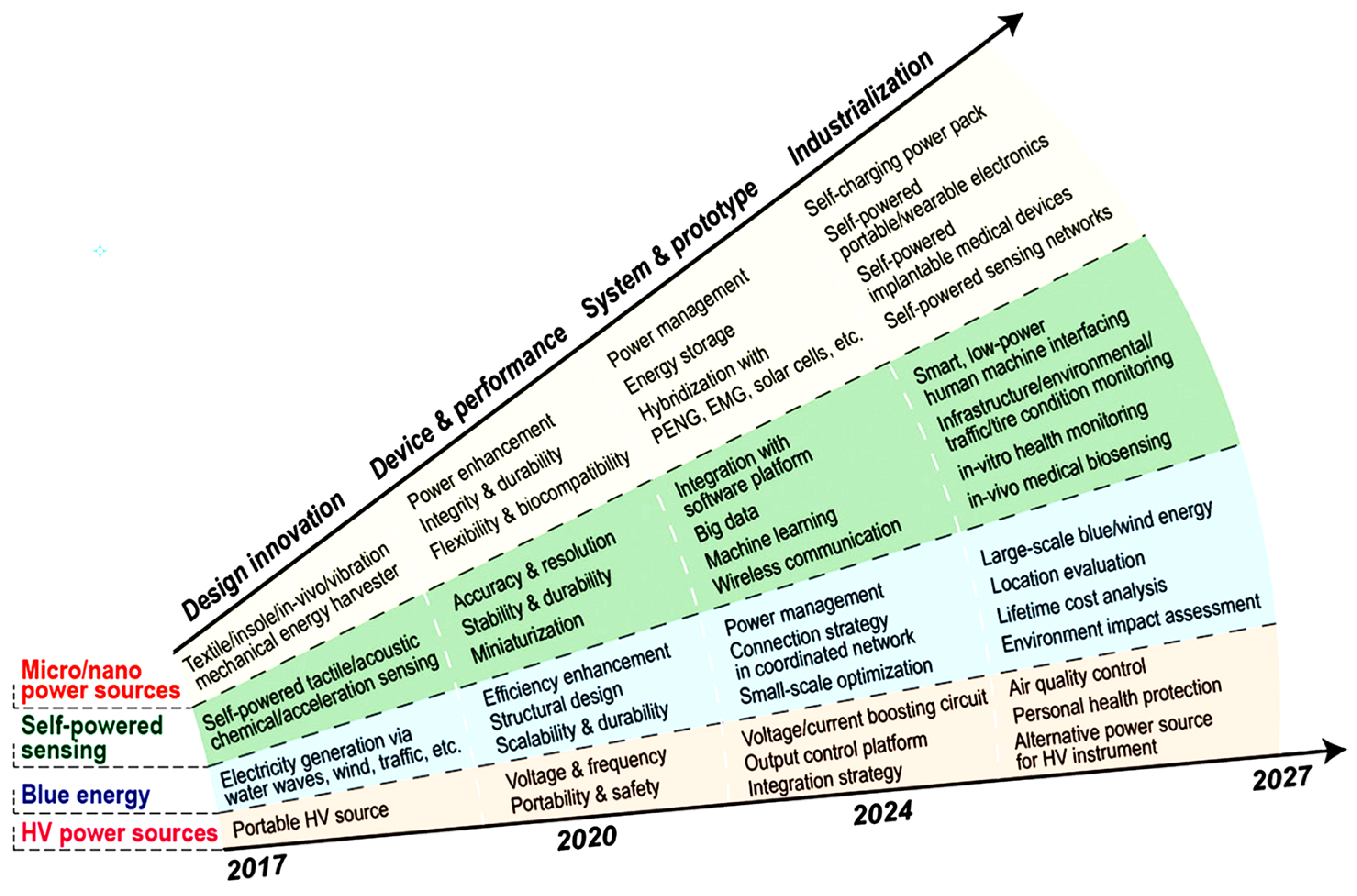
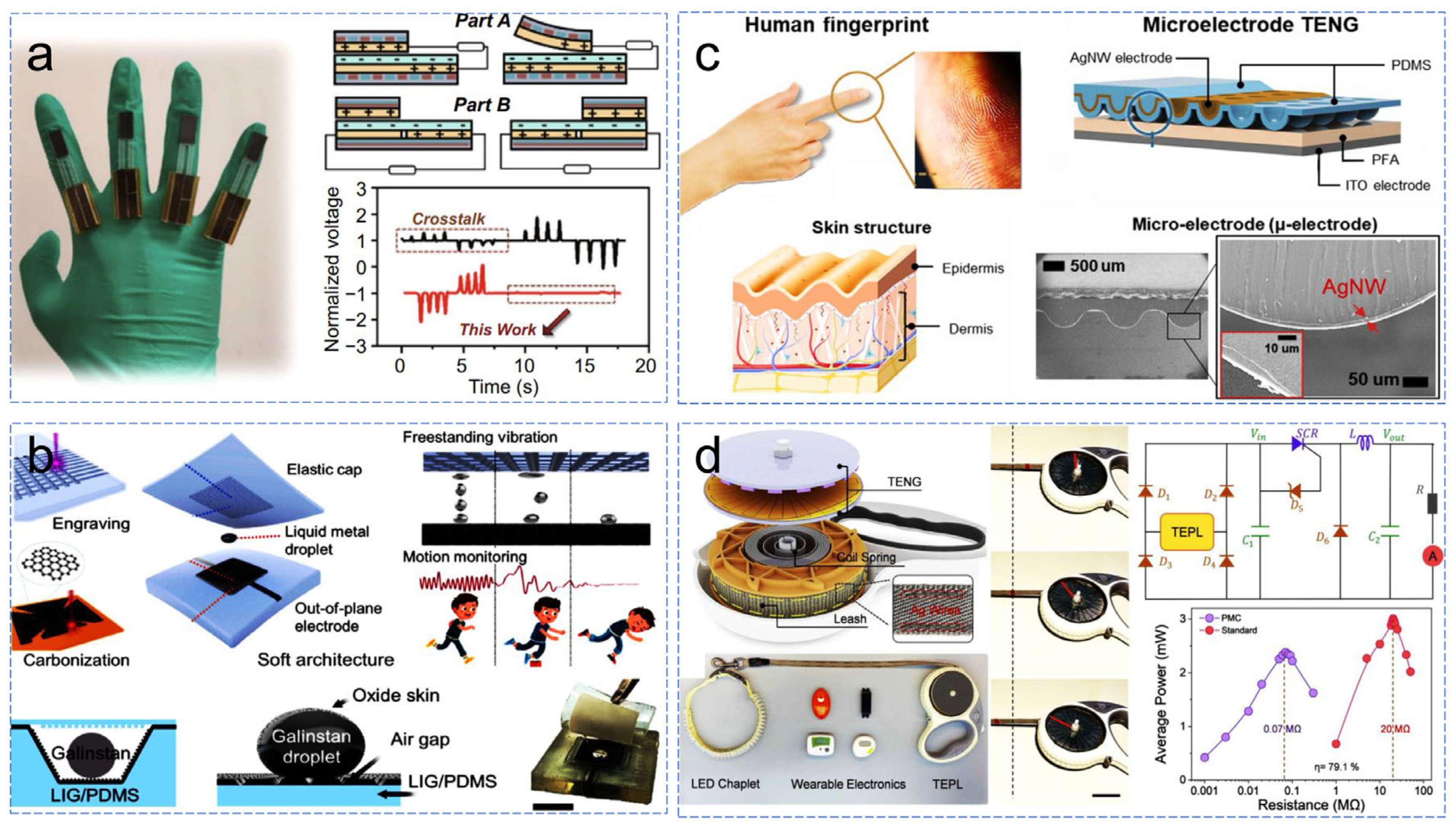


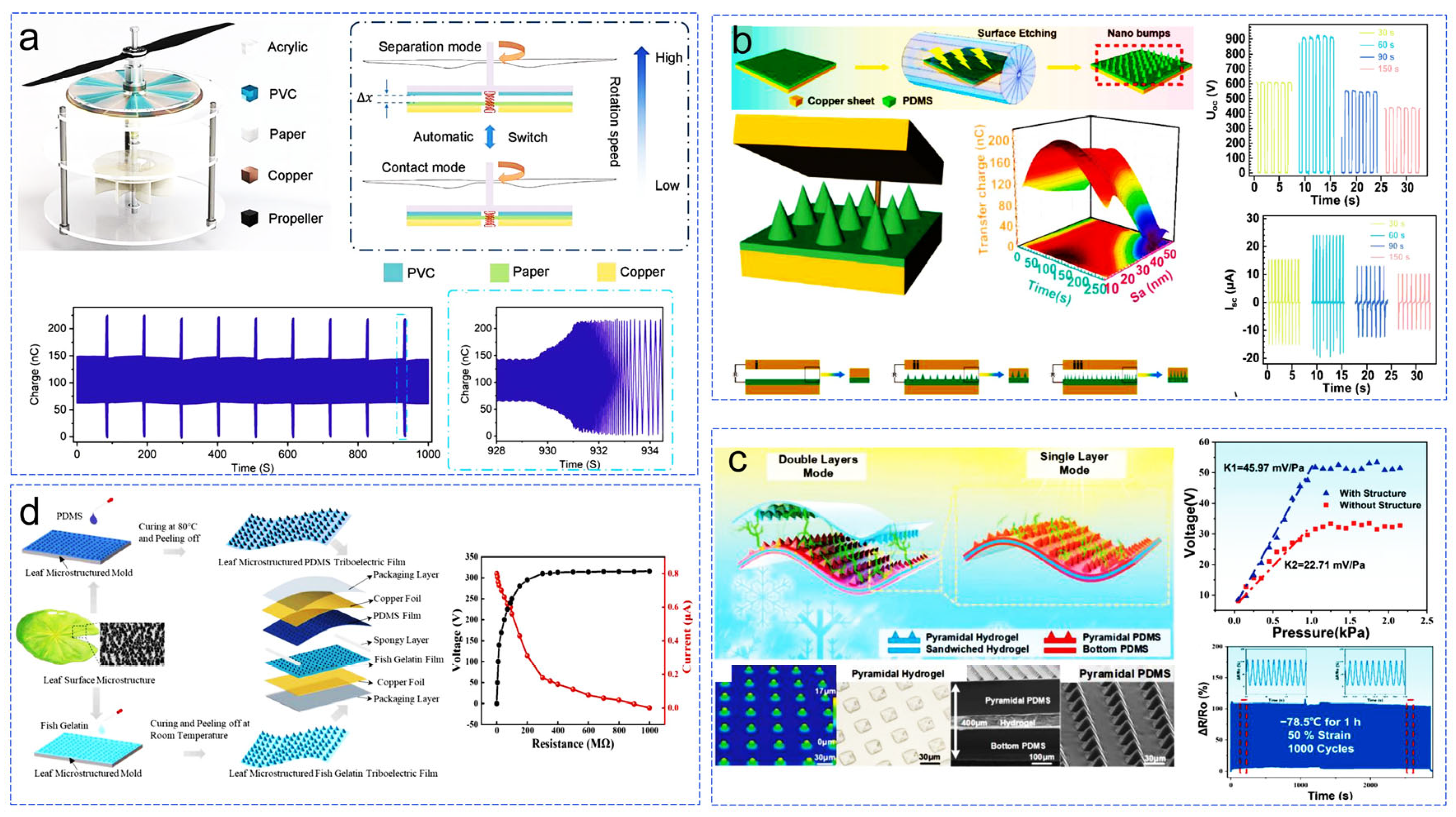
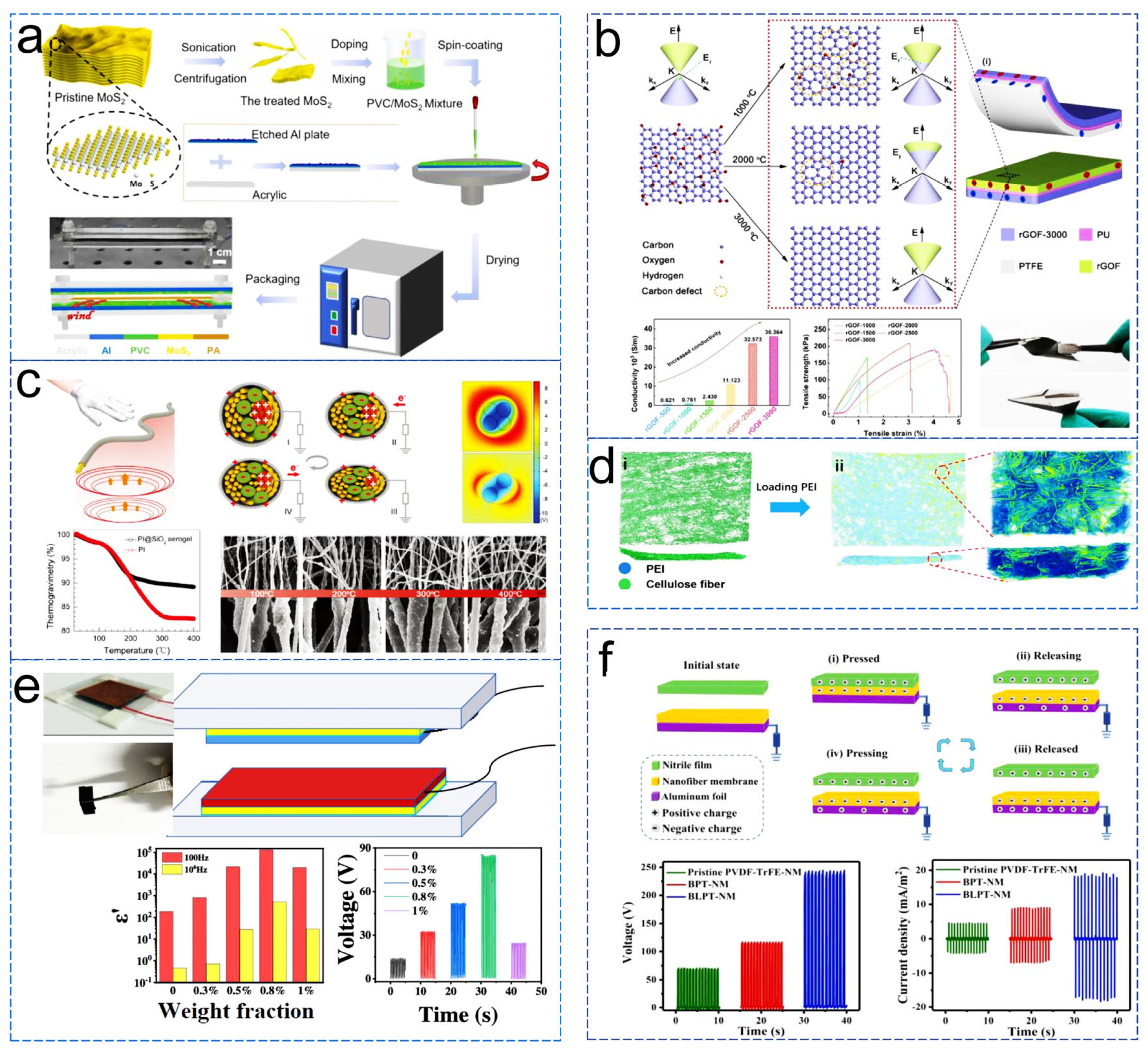
Disclaimer/Publisher’s Note: The statements, opinions and data contained in all publications are solely those of the individual author(s) and contributor(s) and not of MDPI and/or the editor(s). MDPI and/or the editor(s) disclaim responsibility for any injury to people or property resulting from any ideas, methods, instructions or products referred to in the content. |
© 2024 by the authors. Licensee MDPI, Basel, Switzerland. This article is an open access article distributed under the terms and conditions of the Creative Commons Attribution (CC BY) license (https://creativecommons.org/licenses/by/4.0/).
Share and Cite
Shi, Z.; Zhang, Y.; Gu, J.; Liu, B.; Fu, H.; Liang, H.; Ji, J. Triboelectric Nanogenerators: State of the Art. Sensors 2024, 24, 4298. https://doi.org/10.3390/s24134298
Shi Z, Zhang Y, Gu J, Liu B, Fu H, Liang H, Ji J. Triboelectric Nanogenerators: State of the Art. Sensors. 2024; 24(13):4298. https://doi.org/10.3390/s24134298
Chicago/Turabian StyleShi, Zhan, Yanhu Zhang, Jiawei Gu, Bao Liu, Hao Fu, Hongyu Liang, and Jinghu Ji. 2024. "Triboelectric Nanogenerators: State of the Art" Sensors 24, no. 13: 4298. https://doi.org/10.3390/s24134298






